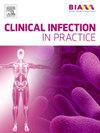播散性组织胞浆菌病引起免疫功能低下患者的噬血细胞性淋巴组织细胞增多症
Q3 Medicine
引用次数: 0
摘要
背景:在免疫功能低下的患者中,寻找噬血细胞淋巴组织细胞病(HLH)的触发因素及其管理可能具有挑战性。在由感染引发的HLH中,免疫抑制疗法可以抑制高脂血症,但可能会加重潜在的感染。目的回顾已有文献对播散性组织浆菌病致HLH免疫功能低下患者的治疗和预后进行综述。方法我们描述了一个病例,并回顾了PubMed上截至2023年6月之前报道的所有弥散性组织胞浆菌病诱导的HLH病例。结果文献回顾共30例。除1例患者外,其余患者均给予抗真菌治疗。18例HLH采用免疫抑制治疗。最常见的免疫抑制方案是皮质类固醇单一疗法和皮质类固醇联合依托泊苷。本病例报告首次描述了阿那白的使用。结论弥散性组织胞浆菌病引起的HLH是一种严重的疾病,需要及时发现并及时干预。目前,这种疾病还没有专门的治疗方案。治疗应根据患者的病情、症状和个人特点量身定制。需要仔细考虑对HLH进行免疫抑制治疗,以防止感染恶化。此外,预测疾病的进展是必要的,以确保及时和适当的干预。本文章由计算机程序翻译,如有差异,请以英文原文为准。
Disseminated histoplasmosis induced hemophagocytic lymphohistiocytosis in an immunocompromised patient
Background
The search for the trigger of hemophagocytic lymphohistiocytosis (HLH) and its management can be challenging in immunocompromised patients. In HLH triggered by infection, immunosuppressive therapy is desired to suppress hyperinflammation, but may worsen the underlying infection.
Objectives
To review available literature on the management and prognosis of immunocompromised patients with disseminated histoplasmosis induced HLH.
Methods
We describe a case and review all previously reported cases of disseminated histoplasmosis induced HLH on PubMed until June 2023.
Results
The literature review yielded 30 cases. Antifungal therapy was administered in all except one patient. In 18 cases, HLH was treated with immunosuppressive therapy. The most common immunosuppressive regimens were corticosteroid monotherapy and corticosteroids combined with etoposide. This case report is the first to describe the use of anakinra. The overall mortality rate was 23.3 % (n = 7).
Conclusions
Disseminated histoplasmosis induced HLH is a severe disorder, requiring prompt recognition and immediate intervention. Currently, no specific treatment protocol exists for this disorder. Treatment should be tailored to the patient’s condition, symptoms and individual characteristics. Careful consideration regarding immunosuppressive therapy for HLH is needed to prevent worsening of the infection. Additionally, anticipating the progression of the disease is necessary to ensure timely and appropriate interventions.
求助全文
通过发布文献求助,成功后即可免费获取论文全文。
去求助
来源期刊

Clinical Infection in Practice
Medicine-Infectious Diseases
CiteScore
2.10
自引率
0.00%
发文量
95
审稿时长
82 days
 求助内容:
求助内容: 应助结果提醒方式:
应助结果提醒方式:


